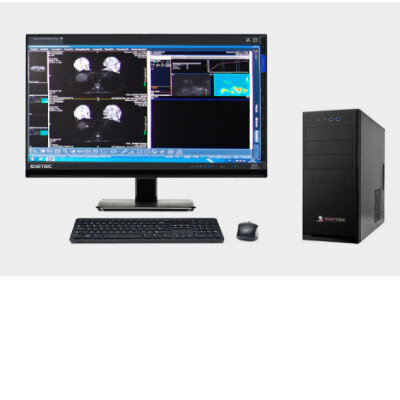Global X-Ray Detectors Market to Surpass USD 4.5 Billion Due to Increasing Use of CT Scans for COVID-19 Diagnosis
|
By MedImaging International staff writers Posted on 25 Oct 2021 |

The global X-ray detectors market is projected to expand at a CAGR of 5.9% during the forecast period of 2021-2031 to reach USD 4.6 billion by 2031, driven mainly by the rising use of radiographic chest scans for COVID-19 diagnosis.
These are the latest findings of Transparency Market Research (Albany, NY, USA), a next-generation market intelligence provider. The market growth will be further aided by the increasing use of X-ray detectors in several applications, growing incidences of gastrointestinal, cardiovascular, oral, and genitourinary disorders and introduction of innovative X-ray detectors for security, industrial, medical, dental, veterinary, and other purposes. In addition, technological advancements that will enable detectors to provide better detail, higher resolution, and decreased exposure will also provide a boost to the global X-ray detectors market.
The use of X-ray detectors for COVID-19 diagnosis will prove to be a key contributor to market growth. Reverse Transcription Polymerase Chain Reaction (RT-PCR) tests are accurate in detecting COVID-19 in individuals, but are very complicated, time-consuming, and costly. Stakeholders in the X-ray detectors market are taking advantage of this opportunity to increase the availability of radiological examination through X-ray such as CT (Computed Tomography) scans, which is a cost-efficient and easily available option. The rising use of X-ray detectors for radiographic chest scans during the COVID-19 pandemic offers substantial growth opportunities.
These detectors are also being optimized by the players for various industrial inspection and material sorting applications. In addition, wider application of X-ray detectors in image-guided radiation therapy, fluoroscopy, digital radiography, cone beam CT, digital tomosynthesis, and others are expected to further fuel market growth. The growing focus of several countries on developing a well-established healthcare infrastructure is also likely to drive the growth of the global X-ray detectors market.
Flat panel detectors are expected to observe a rise in demand, as they offer various advantages such as uniform imaging quality, less image distortion, low time consumption, good reproducibility, and better patient condition access, among others. In addition, they are proven to be very successful in high exposure interventional procedures. Among panel types, the large panel category of the X-ray detectors market is expected to witness promising growth. The growing number of patients undergoing diagnostic imaging tests, and expanding adoption of new and advanced large panel detectors are likely to propel the growth of the X-ray detectors market.
Geographically, North America held the largest share of the global X-ray detectors market in 2020 and is expected to maintain its position during the forecast period. The growing number of dental CBCT scans in the US due to increasing dental diseases among a considerable share of its population is anticipated to propel the growth of the North American X-ray detectors market. Furthermore, the Asia Pacific X-ray detectors market is also projected to grow rapidly during the forecast period. Increasing efforts by several countries in the region to develop a well-established healthcare infrastructure, coupled with novel product launches in China and Japan, are expected to fuel the growth of the X-ray detectors market in the Asia Pacific.
Related Links:
Transparency Market Research
Latest Industry News News
- Bayer and Google Partner on New AI Product for Radiologists
- Samsung and Bracco Enter Into New Diagnostic Ultrasound Technology Agreement
- IBA Acquires Radcal to Expand Medical Imaging Quality Assurance Offering
- International Societies Suggest Key Considerations for AI Radiology Tools
- Samsung's X-Ray Devices to Be Powered by Lunit AI Solutions for Advanced Chest Screening
- Canon Medical and Olympus Collaborate on Endoscopic Ultrasound Systems
- GE HealthCare Acquires AI Imaging Analysis Company MIM Software
- First Ever International Criteria Lays Foundation for Improved Diagnostic Imaging of Brain Tumors
- RSNA Unveils 10 Most Cited Radiology Studies of 2023
- RSNA 2023 Technical Exhibits to Offer Innovations in AI, 3D Printing and More
- AI Medical Imaging Products to Increase Five-Fold by 2035, Finds Study
- RSNA 2023 Technical Exhibits to Highlight Latest Medical Imaging Innovations
- AI-Powered Technologies to Aid Interpretation of X-Ray and MRI Images for Improved Disease Diagnosis
- Hologic and Bayer Partner to Improve Mammography Imaging
- Global Fixed and Mobile C-Arms Market Driven by Increasing Surgical Procedures
- Global Contrast Enhanced Ultrasound Market Driven by Demand for Early Detection of Chronic Diseases
Channels
Radiography
view channel
Novel Breast Imaging System Proves As Effective As Mammography
Breast cancer remains the most frequently diagnosed cancer among women. It is projected that one in eight women will be diagnosed with breast cancer during her lifetime, and one in 42 women who turn 50... Read more
AI Assistance Improves Breast-Cancer Screening by Reducing False Positives
Radiologists typically detect one case of cancer for every 200 mammograms reviewed. However, these evaluations often result in false positives, leading to unnecessary patient recalls for additional testing,... Read moreMRI
view channel
PET/MRI Improves Diagnostic Accuracy for Prostate Cancer Patients
The Prostate Imaging Reporting and Data System (PI-RADS) is a five-point scale to assess potential prostate cancer in MR images. PI-RADS category 3 which offers an unclear suggestion of clinically significant... Read more
Next Generation MR-Guided Focused Ultrasound Ushers In Future of Incisionless Neurosurgery
Essential tremor, often called familial, idiopathic, or benign tremor, leads to uncontrollable shaking that significantly affects a person’s life. When traditional medications do not alleviate symptoms,... Read more
Two-Part MRI Scan Detects Prostate Cancer More Quickly without Compromising Diagnostic Quality
Prostate cancer ranks as the most prevalent cancer among men. Over the last decade, the introduction of MRI scans has significantly transformed the diagnosis process, marking the most substantial advancement... Read moreUltrasound
view channel
Deep Learning Advances Super-Resolution Ultrasound Imaging
Ultrasound localization microscopy (ULM) is an advanced imaging technique that offers high-resolution visualization of microvascular structures. It employs microbubbles, FDA-approved contrast agents, injected... Read more
Novel Ultrasound-Launched Targeted Nanoparticle Eliminates Biofilm and Bacterial Infection
Biofilms, formed by bacteria aggregating into dense communities for protection against harsh environmental conditions, are a significant contributor to various infectious diseases. Biofilms frequently... Read moreNuclear Medicine
view channel
New SPECT/CT Technique Could Change Imaging Practices and Increase Patient Access
The development of lead-212 (212Pb)-PSMA–based targeted alpha therapy (TAT) is garnering significant interest in treating patients with metastatic castration-resistant prostate cancer. The imaging of 212Pb,... Read moreNew Radiotheranostic System Detects and Treats Ovarian Cancer Noninvasively
Ovarian cancer is the most lethal gynecological cancer, with less than a 30% five-year survival rate for those diagnosed in late stages. Despite surgery and platinum-based chemotherapy being the standard... Read more
AI System Automatically and Reliably Detects Cardiac Amyloidosis Using Scintigraphy Imaging
Cardiac amyloidosis, a condition characterized by the buildup of abnormal protein deposits (amyloids) in the heart muscle, severely affects heart function and can lead to heart failure or death without... Read moreGeneral/Advanced Imaging
view channel
New AI Method Captures Uncertainty in Medical Images
In the field of biomedicine, segmentation is the process of annotating pixels from an important structure in medical images, such as organs or cells. Artificial Intelligence (AI) models are utilized to... Read more.jpg)
CT Coronary Angiography Reduces Need for Invasive Tests to Diagnose Coronary Artery Disease
Coronary artery disease (CAD), one of the leading causes of death worldwide, involves the narrowing of coronary arteries due to atherosclerosis, resulting in insufficient blood flow to the heart muscle.... Read more
Novel Blood Test Could Reduce Need for PET Imaging of Patients with Alzheimer’s
Alzheimer's disease (AD), a condition marked by cognitive decline and the presence of beta-amyloid (Aβ) plaques and neurofibrillary tangles in the brain, poses diagnostic challenges. Amyloid positron emission... Read more.jpg)
CT-Based Deep Learning Algorithm Accurately Differentiates Benign From Malignant Vertebral Fractures
The rise in the aging population is expected to result in a corresponding increase in the prevalence of vertebral fractures which can cause back pain or neurologic compromise, leading to impaired function... Read moreImaging IT
view channel
New Google Cloud Medical Imaging Suite Makes Imaging Healthcare Data More Accessible
Medical imaging is a critical tool used to diagnose patients, and there are billions of medical images scanned globally each year. Imaging data accounts for about 90% of all healthcare data1 and, until... Read more
Global AI in Medical Diagnostics Market to Be Driven by Demand for Image Recognition in Radiology
The global artificial intelligence (AI) in medical diagnostics market is expanding with early disease detection being one of its key applications and image recognition becoming a compelling consumer proposition... Read moreIndustry News
view channel
Bayer and Google Partner on New AI Product for Radiologists
Medical imaging data comprises around 90% of all healthcare data, and it is a highly complex and rich clinical data modality and serves as a vital tool for diagnosing patients. Each year, billions of medical... Read more





















